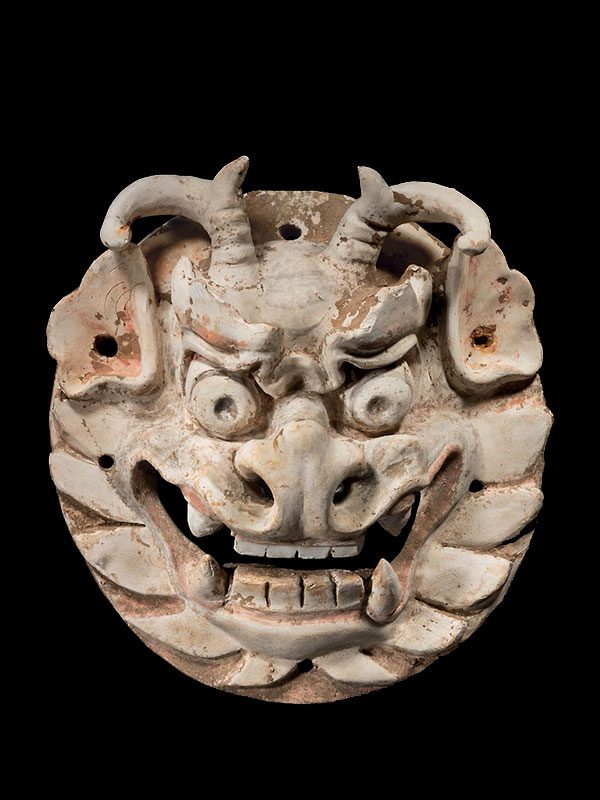Pottery monster mask
A pottery mask of a monster, the rounded face moulded in high relief with fierce features. The monster has large bulging eyes and pronounced eyebrows over a wide mouth, half opened to reveal its sharp teeth. Its large nose is upturned and two antler-shaped horns protrude from the top of its head. The big ears and the mane are spread around the face. The mask has several holes for attachment. There are some traces of red and black pigments on the surface of the pottery, which further emphasize the ferocious features.
In a tradition dating from at least the Han dynasty (206 BC – 220 AD), the doors of the inner burial chambers of large tombs bore the head of a monster combined with a ring in the form of a door knocker, known in Chinese as ‘pu shou’. They were normally made of metal, such as a gilded bronze pu shou excavated from Chengdu city, Sichuan province in 1942, which is dated to the Great Shu kingdom (907 – 925) of the Five Dynasties and now in the collection of the Yongling Museum in Chengdu city.1 This device is rare in the Tang period and appears to be revived in earthenware as a deliberate archaism. A closely comparable Tang dynasty pottery horned monster mask of similar size and also with bared teeth is in the collection of Anthony M. Solomon, exhibited at Harvard in 2002.2 A smaller green-glazed pottery horned monster biting a ring, similar in the ferocious manner and dated to the first half of the 8th century, is in the collection of the Fitzwilliam Museum, Cambridge.3 An example of a 7th century monster mask of square shape, which was possibly used as decoration of a Buddhist shrine, is in the collection of the British Museum.4
- The Yongling Museum online collection archive, webpage: http://www.cdylbwg.org /productshow.aspx?mid=424&id=71
- Bower, V. L. From Court to Caravan – Chinese Tomb Sculpture from the Collection of Anthony M. Solomon, Harvard University Art Museums, Cambridge, 2002, no. 49, p. 133
- Watson, W. Tang and Liao Ceramics, Thames & Hudson, London, 1984. pl. 143, pp. 160-1
- Watson, W. op. cit. pl. 28, pp. 50-1

